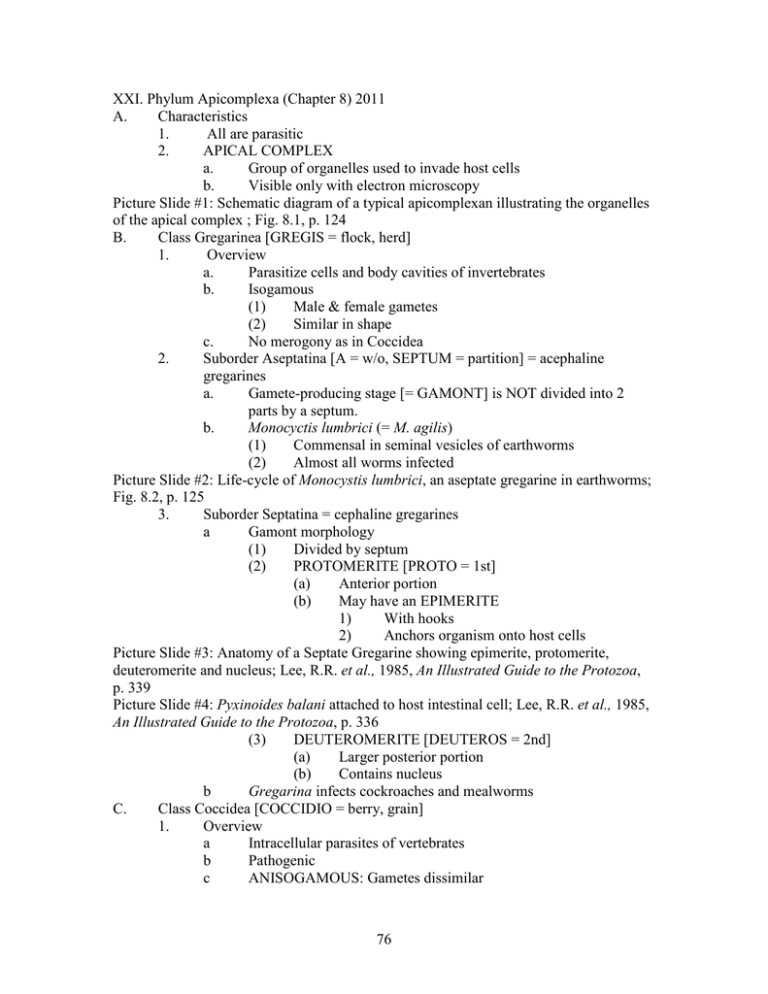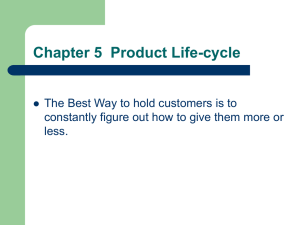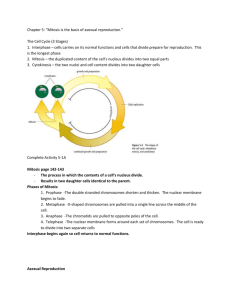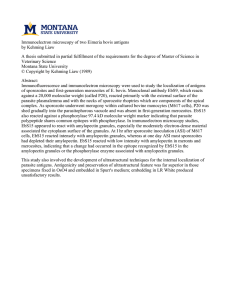XXI. Phylum Apicomplexa (Chapter 8) 2011 A. Characteristics
advertisement

XXI. Phylum Apicomplexa (Chapter 8) 2011 A. Characteristics 1. All are parasitic 2. APICAL COMPLEX a. Group of organelles used to invade host cells b. Visible only with electron microscopy Picture Slide #1: Schematic diagram of a typical apicomplexan illustrating the organelles of the apical complex ; Fig. 8.1, p. 124 B. Class Gregarinea [GREGIS = flock, herd] 1. Overview a. Parasitize cells and body cavities of invertebrates b. Isogamous (1) Male & female gametes (2) Similar in shape c. No merogony as in Coccidea 2. Suborder Aseptatina [A = w/o, SEPTUM = partition] = acephaline gregarines a. Gamete-producing stage [= GAMONT] is NOT divided into 2 parts by a septum. b. Monocyctis lumbrici (= M. agilis) (1) Commensal in seminal vesicles of earthworms (2) Almost all worms infected Picture Slide #2: Life-cycle of Monocystis lumbrici, an aseptate gregarine in earthworms; Fig. 8.2, p. 125 3. Suborder Septatina = cephaline gregarines a Gamont morphology (1) Divided by septum (2) PROTOMERITE [PROTO = 1st] (a) Anterior portion (b) May have an EPIMERITE 1) With hooks 2) Anchors organism onto host cells Picture Slide #3: Anatomy of a Septate Gregarine showing epimerite, protomerite, deuteromerite and nucleus; Lee, R.R. et al., 1985, An Illustrated Guide to the Protozoa, p. 339 Picture Slide #4: Pyxinoides balani attached to host intestinal cell; Lee, R.R. et al., 1985, An Illustrated Guide to the Protozoa, p. 336 (3) DEUTEROMERITE [DEUTEROS = 2nd] (a) Larger posterior portion (b) Contains nucleus b Gregarina infects cockroaches and mealworms C. Class Coccidea [COCCIDIO = berry, grain] 1. Overview a Intracellular parasites of vertebrates b Pathogenic c ANISOGAMOUS: Gametes dissimilar 76 2. Life-cycle stages may all occur within one host and the outside environment or involve alternation between two hosts 3. Life-cycle (Fig. 8.7, p. 131) a. First asexual reproduction (1) Trophozoites (= sporozoites) invade host cells and develop into SCHIZONTS [SCHIZA = splinter] which are multinucleated stages (2) Schizonts undergo SCHIZOGONY (multiple fission) to produce daughter cells known as MEROZOITES [MEROS = part, portion] Picture Slide #6: Life-cycle of the coccidian Eimeria tenella showing 1st, 2nd asexual reproduction and sexual reproduction ; Fig. 8.7, p. 131 (3) Most merozoites invade more host cells and repeat schizogony (also called MEROGONY at this stage). (4) Reminder: There is NO merogony in the Gregarina b. Sexual reproduction (1) Other merozoites invade host cells and undergo GAMETOGONY to produce gametes (a) Female macrogametes (large) (b) Male microgametes (small) (2) Gametes fuse to become ZYGOTES c. Second asexual reproduction (1) Zygotes form a protective wall and become OOCYSTS (2) SPORONTS develop within oocyst, out of which hatch SPOROZOITES Picture Slide #6: Life-cycle of the coccidian Eimeria tenella showing 1st, 2nd asexual reproduction and sexual reproduction ; Fig. 8.7, p. 131 4. Order Eimeriida Family Eimeriidae a. Parasites of farm animals (poultry, cattle & sheep) and humans b. COCCIDIOSIS (1) Epithelial tissue attacked (2) Disease is self-limiting (a) Fixed number of schizont generations (b) All merozoites become gametocytes and life-cycle is completed (c) Pathogenicity depends upon size of initial infection c. Eimeria (1) Usually infects epithelial cells in vertebrate intestines (2) Over 1,000 described species (3) E. stiedae infects rabbits (lab slides) d. Family Sarcocystidae (1) Specialized terms for this family (a) TACHYZOITES 1) Merozoites that have been released from host cells 77 2) Free in body fluids (b) BRADYZOITES 1) Merozoites in cysts in host tissues 2) Undergo slow asexual reproduction (2) Toxoplasma gondii (Fig. 8.12, p. 135) (a) Single species that infects vertebrates world-wide 1) Most common, infectious, pathogenic animal (zoonotic) parasite of humans; estimated that 13% of humans are infected 2) Second leading killer of farm animal fetuses in England (b) Transmission 1) Felines (= domestic cats) are the ONLY final host (Sexual reproduction occurs in oocysts) 2) Herbivores eat sporozoites in food or water 3) Carnivores acquire sporozoites from eating uncooked meat 4) Humans (= pregnant women) get infected by a) Eating poorly cooked meat b) Handling cat feces (Pregnant women should NOT empty litter boxes) c) Cat feces to roaches or flies to food (c) Live in host cell cytoplasm 1) Usually epithelium and white blood cells 2) Also muscle and nervous tissue (d) CONGENITAL TOXOPLASMOSIS 1) Fetus acquires parasite from mother a) Invades central nervous system b) Infection after beginning of pregnancy is most dangerous time 2) Pathogenicity a) Often fatal to infants b) May be a major cause of miscarriages Picture Slide #7: Life-cycle of the coccidian Toxoplasma gondii; From Johnson, AM. 1997, Parasitology Today 13:393-397 (3) Sarcocystis (a) Occurs in muscular tissue of mammals (including humans) and birds (b) Life-cycle a) Intermediate hosts are herbivores b) Final hosts are predators c) Sporocysts in predator feces infect herbivores 78 (c) 75-98% of U.S. cattle are infected (d) Can be fatal Picture Slide #8: Life-cycle of the coccidian Sarcocystis; Fig 8.16, p. 139 Picture Slides #5: A Gay Life-style and Parasitic Diseases “I calculated that since becoming sexually active in 1973, I had racked up more than three thousand different sex partners in bathhouses, backrooms, meat racks and teahouses,” gay pop singer Michael Callen wrote. “As a consequence, I also had the following sexually transmitted diseases, many more than once: hepatitis A, hepatitis B, hepatitis non-A/non-B; herpes simplex Types I and II; venereal warts; giardia lamblia and entamoeba histolytica; shigella flexneri and salmonella; syphilis; gonorrhea; nonspecific urethritis; chlamydia; cytomegalovirus (CMV), and Epstein-Barr virus (EBV) mononucleosis; and eventually cryptosporidiosis.” From: Garrett, L. 1994, The Coming Plague, Penguin Books, p. 271 quoting M. Callen 1990, Surviving AIDS, Harper-Collins. (4) Cryptosporidium (pp. 141-43) (a) Occurs in epithelial tissue of mammals (including humans) and birds (b) Important cause of death in AIDS patients, but although unpleasant, not normally dangerous to people with healthy immune systems (c) Invade epithelial cells lining respiratory tract as well as the ileum and colon (d) In April 1993, 400,000 people became sick in Milwaukee, Wisconsin from drinking contaminated city water (e) Small size (2-6 microns) makes it difficult to detect (f) No effective drug treatment Picture Slide #9: 3-D Reconstruction of a sporozoite of Cryptosporidium parvum showing nucleus and apical complex; Coombs, 1999, Parasit. Today 15:334 modified from Tetly 1998 Microbiology 144:3249-55 Picture Slide #10: Oocysts of Cryptosporidium parvum showing emerging sporocysts; Fig. 8.21, p. 142 Parasitic Diseases and AIDS As the Christmas holidays of 1981 approached, scientists with the CDC and numerous U.S. medical centers reviewed the data on what they had dubbed GRID, GayRelated Immunodeficiency Disease. It had occurred in 270 known U.S. cases during 1981, most--- but not all---of whom were young, homosexual male adults. Two leading symptoms marked the GRID syndrome: Kaposi’s sarcoma and Pneumocystis carinii pneumonia. But other odd ailments were also seen: thrush, caused by Candida fungal infections; pronounced herpes simplex-II throughout the body; blood contamination of active cytomegalovirus with unknown effect; mononucleosis due to Epstein-Barr virus; marked lymph node swelling; radical infections of the stomach and gastrointestinal tract with Entamoeba histolytica; diarrhea and gastric problems caused by the Cryptosporidium parasite; similar symptoms caused by, of all things, Mycobacterium avium, a tuberculosis bacteria usually found in chickens; galloping infections in many 79 organs of the Cryptococcus fungus; out-of-control bacterial infections with common organisms, such as Staphylococcus aureus, Escherichia coli, and Klebsiella. Garrett, L. 1994, The Coming Plague, Penguin Books, p. 293 80









